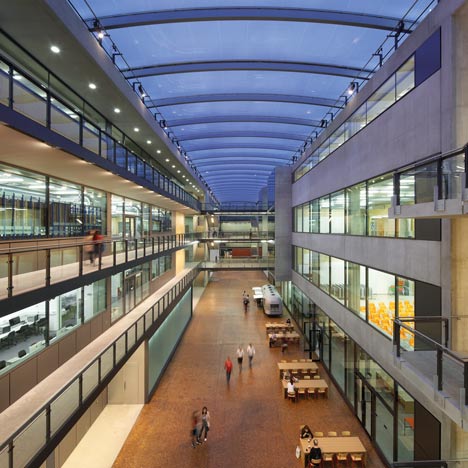
Overseas applications to UK architecture and design courses "highest on record"
News: record numbers of overseas students have applied to study architecture and design courses in the UK, with applications up 14% on last year.
A total of 13,620 non-EU students have submitted applications for design courses starting in 2014, with a further 6,310 seeking places on architecture courses.
The latest figures were released last week by UCAS, the organisation that coordinates students seeking places at UK higher education institutions.
"The 2014 application figures for non-EU applicants for Group K [architecture, building and planning courses] and W [creative, arts and design] are the highest on record," a UCAS spokesman told Dezeen.
Foreign applications to study art and design courses in the UK leapt 15% while architecture, building and planning courses saw an increase of 13%.
However the number of UK students applying for design courses grew just 4%, while home-grown students wanting to study architecture fell 3%.
Robert Mull, dean and director of architecture at Sir John Cass Faculty of Art, Architecture and Design, said that concerns over rising fees was putting UK students off studying architecture due to the length of time it takes to qualify.
"Higher fees, debt and the fear of debt is impacting on home students in complex ways that we do not yet fully understand, said Mull. "However it is clear that long professional courses like architecture are where the effect will be seen first."
UK architecture students must study for five years in order to become fully qualified architects, but with obligatory work placements and Part III examinations, the process can take up to ten years.
The number of UK students seeking places on domestic architecture courses has been falling steadily since 2010. Just 24,650 applied to start in 2014, compared with 33,550 in 2010.
Last year's Farrell Review of UK architecture policy found that architecture students are currently "spending close to £100,000" on their studies.
Mull, whose school is part of London Metropolitan University, said: "The situation needs to be watched as it has the potential to exclude particular groups of students from education whose diverse life experience is essential to the future of the creative disciplines".
The total export value of the UK higher education sector is £17.5bn, according to the Department for Business, Innovation & Skills.
Leading voices in the creative industries have recently raised concerns that new visa restrictions making it difficult for foreigners to stay in the UK after graduating could damage the economy.
"London has really based its success [as a centre for creative businesses] on having 150 years of great art schools," Design Museum director Deyan Sudjic told Dezeen last year. "They have been somewhat industrialised, got too big, and the government has also got quite curious about allowing students to stay once they've graduated. We need to be an open city, that's what London always been."
Despite the growth in overseas applications the total number of people wanting to study architecture and planning courses in 2014 is down 2% compared to 2013.
Main image: view of the central atrium at Central St Martins school and art and design in London, designed by Stanton Williams.
Last year, Dezeen columnist Sam Jacob argued that "architectural education must change" in the UK as it was too expensive, lengthy and inflexible.
A total of 279,120 people applied to take architecture and design courses in this year's intake.